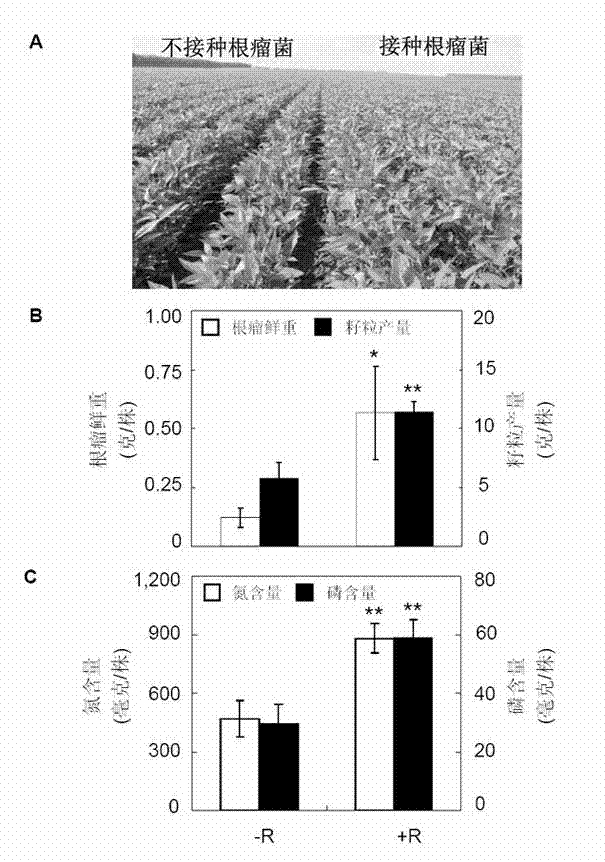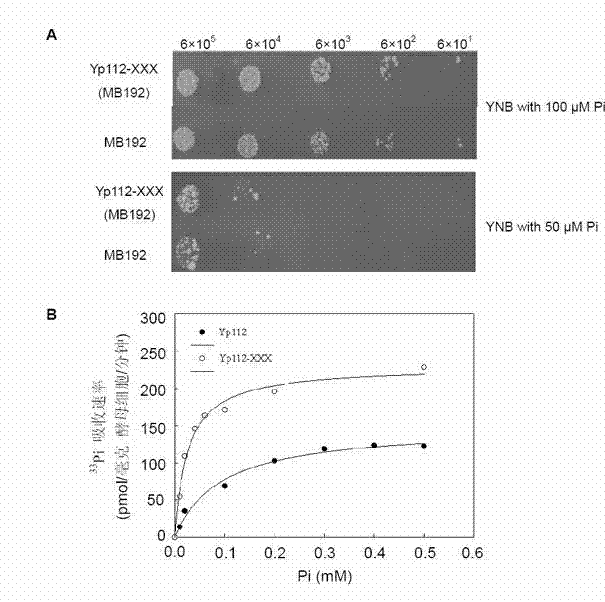Phosphorus transportprotein gene GmPT5 related to phosphorus transport of soybean nodulation and application thereof
A technology of soybean root nodule and transporter protein, applied in the field of plant biology
- Summary
- Abstract
- Description
- Claims
- Application Information
AI Technical Summary
Problems solved by technology
Method used
Image
Examples
Embodiment 1
[0048] GmPT5 gene cloning
[0049] 1. Gene ( GmPT5 ) clone
[0050] In the published soybean genome database, a total of 14 members of the soybean Pht1 phosphorus transporter family were predicted by homologous comparison. GmPT5 The gene is a low-phosphorus-induced, high-affinity phosphorus transporter gene specifically expressed in root nodules. According to the TRIzol one-step method, the total RNA of soybean root nodules of HN98 high-efficiency phosphorus genotype was extracted, and the whole genome cDNA was obtained by reverse transcription as a template, and upstream primers were used:
[0051] 5'-ATGGGGAAGGAGCAAGTTCAGG-3' (SEQ ID NO:3)
[0052] and downstream primers:
[0053] 5'- TTACACCTTGGTCTCCTCTTCTTG-3' (SEQ ID NO: 4)
[0054] For primers, perform PCR amplification. The PCR reaction system is 50 μL, including 1 μL of 10 μM forward and reverse primers, 5 μL of 10×PCR buffer, 8 μL of 2.5 mM dNTP, 0.3 μL of Taq enzyme, and 1 μL of cDNA template. Then use sterile...
Embodiment 2
[0086] Study on Transgenic Compound Plants
[0087] 1. Obtaining of transgenic compound plants
[0088] The constructed expression vector plasmid was transformed into Agrobacterium rhizogenes K599, and the transgenic composite plants (transgenic hairy root in the root and non-transgenic in the shoot) were obtained by Agrobacterium-mediated soybean hypocotyl injection. This strain was used for type identification. Empty vector control: According to the above method, the expression vector pYLRNAi was transformed into soybean in the same way to obtain a pYLRNAi-transformed empty vector control line (CK).
[0089] 2. Detection of transgenic compound plants
[0090] 15 days after inoculation, the root samples were first taken to extract RNA, and the transgenic hairy roots were screened for hygromycin, and the hygromycin resistance gene ( Hyg ) to detect the authenticity of hair roots; 40 days after inoculation, when the root nodules were in the mature stage, two root nodules we...
PUM
 Login to View More
Login to View More Abstract
Description
Claims
Application Information
 Login to View More
Login to View More - R&D
- Intellectual Property
- Life Sciences
- Materials
- Tech Scout
- Unparalleled Data Quality
- Higher Quality Content
- 60% Fewer Hallucinations
Browse by: Latest US Patents, China's latest patents, Technical Efficacy Thesaurus, Application Domain, Technology Topic, Popular Technical Reports.
© 2025 PatSnap. All rights reserved.Legal|Privacy policy|Modern Slavery Act Transparency Statement|Sitemap|About US| Contact US: help@patsnap.com



